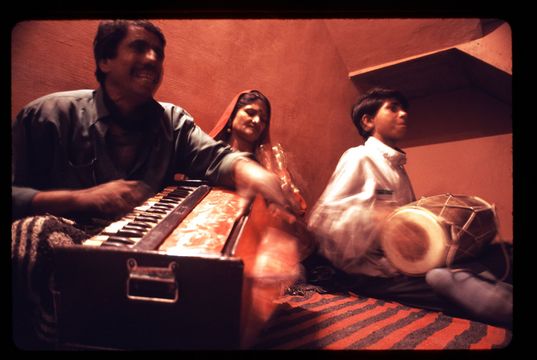 Family of musicians performing in Bikaner, Rajasthan.
Family of musicians performing in Bikaner, Rajasthan. |
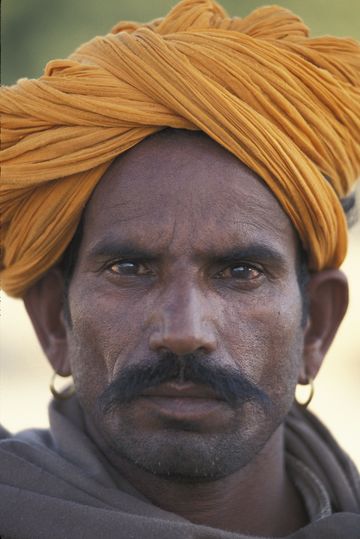 It's really stunning how willing people are in India to have their picture taken - even to relish it, as this man did - if you just ask.
It's really stunning how willing people are in India to have their picture taken - even to relish it, as this man did - if you just ask. |
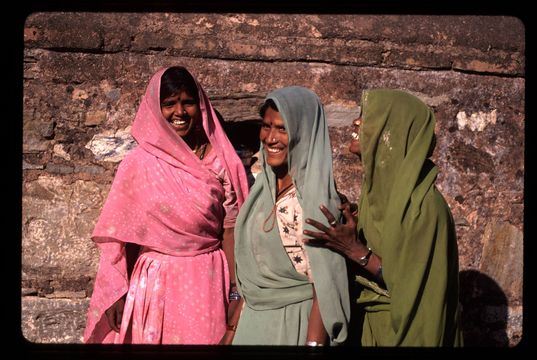 These women were in Chittaurgarh, an old military fort far away from cities, unlike many of the other Raj palaces.
These women were in Chittaurgarh, an old military fort far away from cities, unlike many of the other Raj palaces. |
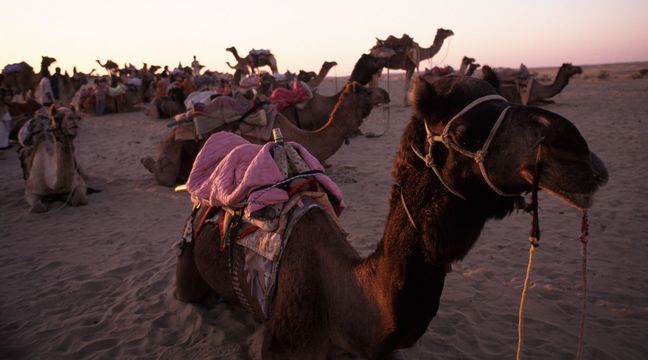 Camels loafing around the Sam Sand Dunes, Rajastan.
Camels loafing around the Sam Sand Dunes, Rajastan. |
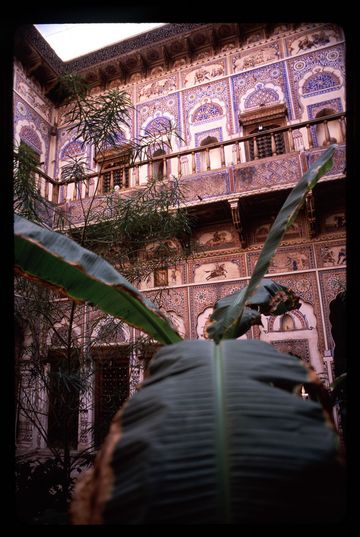 A restored havleli in Fatehpur, Rajasthan.
A restored havleli in Fatehpur, Rajasthan. |
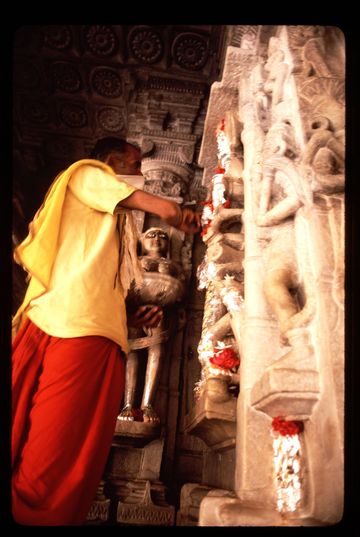 A jain holy man cleaning sculptures in the temple at Osiyan. He is wearing a mask to prevent him inhaling any insects, as part of a devout Jain practice of not harming any living thing.
A jain holy man cleaning sculptures in the temple at Osiyan. He is wearing a mask to prevent him inhaling any insects, as part of a devout Jain practice of not harming any living thing. |
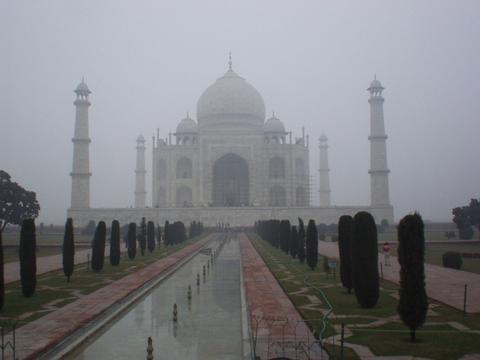 Obligatory Taj Mahal picture. It was a foggy day, and the Taj blended into the fog. There was a mosque on the west side of it -- and, interestingly, on the east side there was a mirror image of that mosque, a building serving only to keep the symmetry: since it wasn't facing Mecca, it couldn't be used for worship.
Obligatory Taj Mahal picture. It was a foggy day, and the Taj blended into the fog. There was a mosque on the west side of it -- and, interestingly, on the east side there was a mirror image of that mosque, a building serving only to keep the symmetry: since it wasn't facing Mecca, it couldn't be used for worship.
|
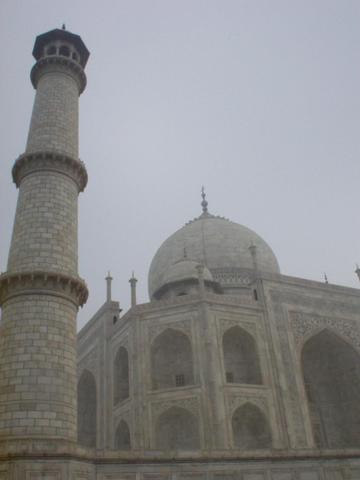 Close up of the Taj.
Close up of the Taj. |
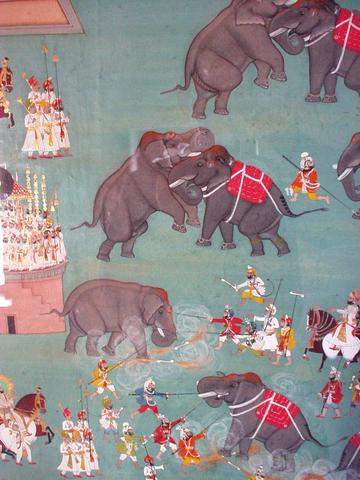 Miniature painting, Udaipur. I spent most of the time in Udaipur being food-poisoned, so I only got out to take one digital picture; most of the miniature paintings in the city palace, like this one, seemed to depict noblemen fighting against either elephants or tigers, seemlingly for sport.
Miniature painting, Udaipur. I spent most of the time in Udaipur being food-poisoned, so I only got out to take one digital picture; most of the miniature paintings in the city palace, like this one, seemed to depict noblemen fighting against either elephants or tigers, seemlingly for sport. |
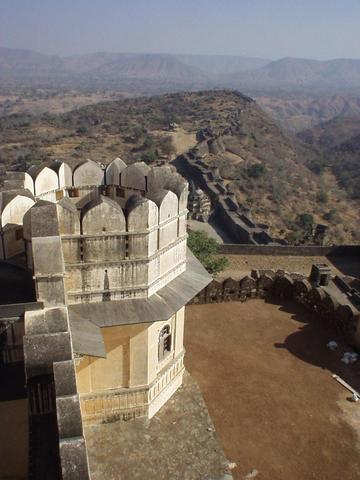 The fort at Kumbhalgarh; this is in a remote area and there were few tourists around. The black wall that you see receding into the distance is 23 miles long, enclosing a large area around the fort, with temples and a village that is still thriving (largely employed in restoring the fort, it seems).
The fort at Kumbhalgarh; this is in a remote area and there were few tourists around. The black wall that you see receding into the distance is 23 miles long, enclosing a large area around the fort, with temples and a village that is still thriving (largely employed in restoring the fort, it seems). |
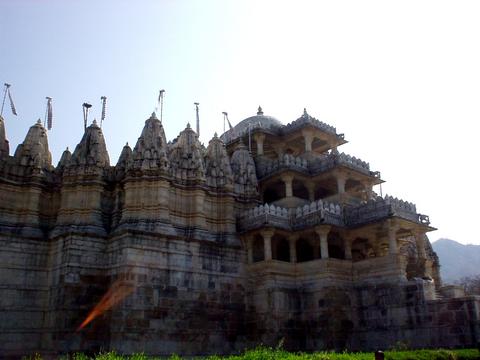 The Jain Temple at Ranakpur, "one of the largest and most important Jain temples in India," according to Lonely Planet. It's large and seemed important; the amount of labor involved in the carving of the 1,444 pillars inside (no two are the same) is breathtaking.
The Jain Temple at Ranakpur, "one of the largest and most important Jain temples in India," according to Lonely Planet. It's large and seemed important; the amount of labor involved in the carving of the 1,444 pillars inside (no two are the same) is breathtaking. |
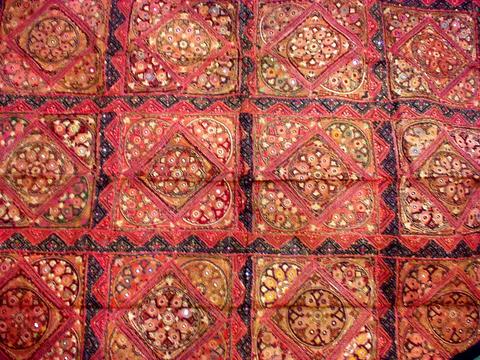 In Jodhpur we visited a merchant who sold these wall hanging/floor coverings that were made from the dresses that Rajasthani women would traditionally sew as dowry; he said that the art had been lost, so they are no longer made. Each one went for about two hundred and thirty dollars.
In Jodhpur we visited a merchant who sold these wall hanging/floor coverings that were made from the dresses that Rajasthani women would traditionally sew as dowry; he said that the art had been lost, so they are no longer made. Each one went for about two hundred and thirty dollars. |
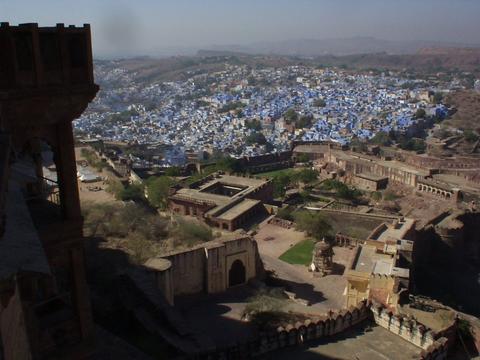 Jodhpur fort and the Blue City.
Jodhpur fort and the Blue City. |
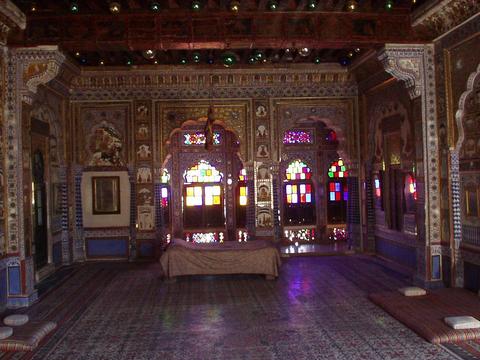 Room in the Meherangarh, the fort of Jodhpur; I didn't note which room it was, but the very colorful rooms like this, with glass or mirrors, were usually the residences of either the Maharaja or one of his ranis (wives).
Room in the Meherangarh, the fort of Jodhpur; I didn't note which room it was, but the very colorful rooms like this, with glass or mirrors, were usually the residences of either the Maharaja or one of his ranis (wives). |
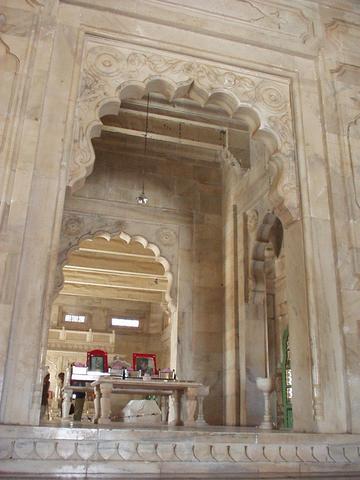 Interior of the Jaswant Thada. There is a kind of altar in here where people tie a piece of string around their wrist and around a balustrade, and then break it, leaving half tied around their wrist, half around the balustrade; somebody (The Majaraja? A god? I forget.) then intervenes and helps them with some wish; when it is granted, they're supposed to come back and collect the string they left behind.
Interior of the Jaswant Thada. There is a kind of altar in here where people tie a piece of string around their wrist and around a balustrade, and then break it, leaving half tied around their wrist, half around the balustrade; somebody (The Majaraja? A god? I forget.) then intervenes and helps them with some wish; when it is granted, they're supposed to come back and collect the string they left behind. |
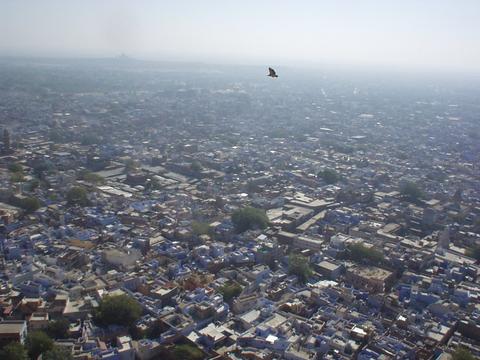 Every city seems to have a color in Rajasthan: Jaipur is the Pink City (it's walls were painted that color, associated with hospitality, to welcome the Prince of Wales who would become King Edward VII), Jaisalmer is the Golden City (named after the color of the rock from which the fort there was built), and Jodhpur is the Blue City, since many of the homes in the old city are painted that color, which is the traditional color of a Brahmin home (other castes now also paint their homes blue). Here, as seen from the battlements of Jodhpur's fort, a hawk soars above the Blue City.
Every city seems to have a color in Rajasthan: Jaipur is the Pink City (it's walls were painted that color, associated with hospitality, to welcome the Prince of Wales who would become King Edward VII), Jaisalmer is the Golden City (named after the color of the rock from which the fort there was built), and Jodhpur is the Blue City, since many of the homes in the old city are painted that color, which is the traditional color of a Brahmin home (other castes now also paint their homes blue). Here, as seen from the battlements of Jodhpur's fort, a hawk soars above the Blue City. |
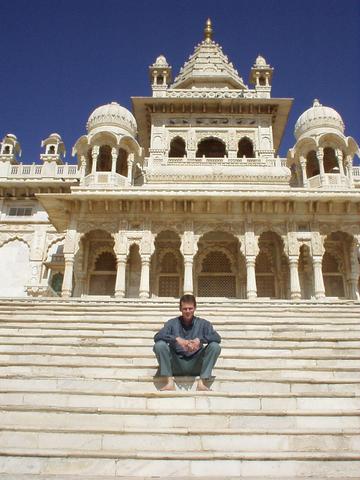 This is a cenotaph of Maharaja Jaswant Singh II, called the Jaswant Thada. It was built in 1899 by his wife, sort of like a reverse Taj Mahal. All of the subsequent maharajas (or would-be maharajas) and other members of the royal family of Jodhpur are memorialized by cenotaphs around it; those of the kings are made of white marble, the others of red sandstone. As an interesting side note, the last maharaja died in the 1950s sometime, when his son, the current maharaja, was only four; the fort has many pictures of his coronation, looking very small and dignified. Oh yeah, and that's me, on the steps.
This is a cenotaph of Maharaja Jaswant Singh II, called the Jaswant Thada. It was built in 1899 by his wife, sort of like a reverse Taj Mahal. All of the subsequent maharajas (or would-be maharajas) and other members of the royal family of Jodhpur are memorialized by cenotaphs around it; those of the kings are made of white marble, the others of red sandstone. As an interesting side note, the last maharaja died in the 1950s sometime, when his son, the current maharaja, was only four; the fort has many pictures of his coronation, looking very small and dignified. Oh yeah, and that's me, on the steps. |
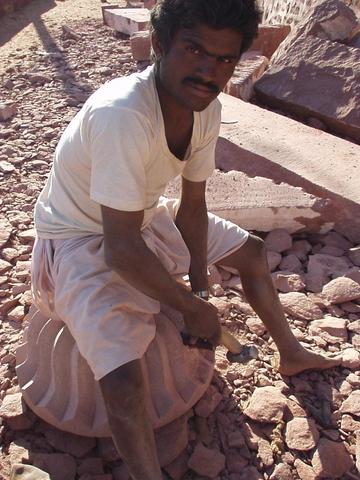 Man carving rock for an addition to a Jain temple, Osiyan, Rajasthan. The Jains are a wealthy community, and it showed from the amount of construction that was going on at their temples, particularly this one at Osiyan, a town between Jaisalmer and Jodhpur.
Man carving rock for an addition to a Jain temple, Osiyan, Rajasthan. The Jains are a wealthy community, and it showed from the amount of construction that was going on at their temples, particularly this one at Osiyan, a town between Jaisalmer and Jodhpur. |
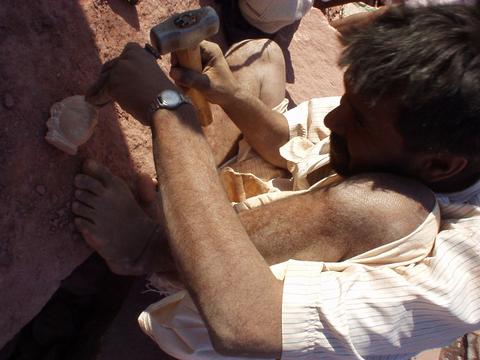 Another man carving out the head of a figure for a pillar or tower of one of the Osiyan temples.
Another man carving out the head of a figure for a pillar or tower of one of the Osiyan temples. |
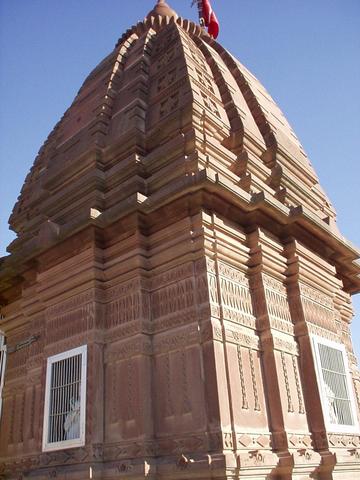 Tower of a Jain temple in Osiyan, Rajasthan.
Tower of a Jain temple in Osiyan, Rajasthan. |
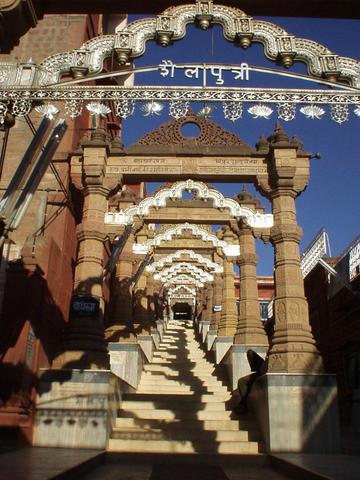 Entrance to the same Jain temple in Osiyan, Rajasthan.
Entrance to the same Jain temple in Osiyan, Rajasthan. |
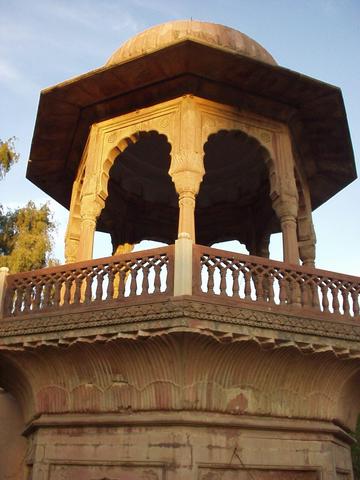 Turret in Junagarh fort, Bikaner. Bikaner is a town somewhat off the tourist track of Rajasthan, on the edge of the Thar desert about eighty miles from the Pakistani border. Turrets like these are a frequent distinguishing mark of Mughal architecture; Junagarh was built in the years 1588-1593 by a general of the great Mughal emperor Akbar.
Turret in Junagarh fort, Bikaner. Bikaner is a town somewhat off the tourist track of Rajasthan, on the edge of the Thar desert about eighty miles from the Pakistani border. Turrets like these are a frequent distinguishing mark of Mughal architecture; Junagarh was built in the years 1588-1593 by a general of the great Mughal emperor Akbar. |
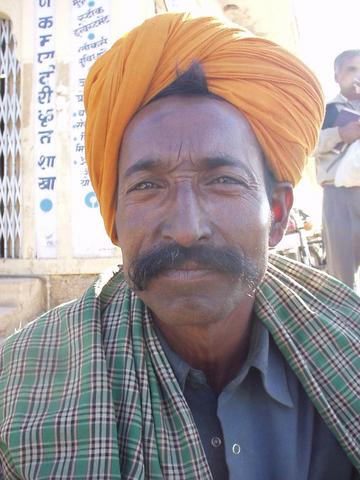 Rajasthani man. They have turbans in orange, pink, yellow, patterened; many colors, but they are always very bright. Big mustaches are also the norm.
Rajasthani man. They have turbans in orange, pink, yellow, patterened; many colors, but they are always very bright. Big mustaches are also the norm. |
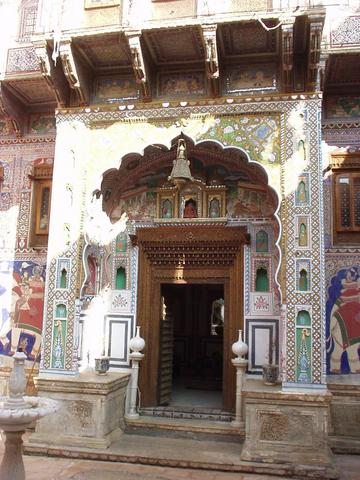 Almost all of the havelis are in a state of deterioration, but there was one that had been bought by a (wealthy) French artist named Nadine Le Prince and totally restored; she stops in once or twice a year with thirty of her closest friends and hangs out. Her caretakeer took me on a tour; it was an impressive sight, especially after seeing all of the other dilapidated havelis. This is one of the doorways in the complex.
Almost all of the havelis are in a state of deterioration, but there was one that had been bought by a (wealthy) French artist named Nadine Le Prince and totally restored; she stops in once or twice a year with thirty of her closest friends and hangs out. Her caretakeer took me on a tour; it was an impressive sight, especially after seeing all of the other dilapidated havelis. This is one of the doorways in the complex. |
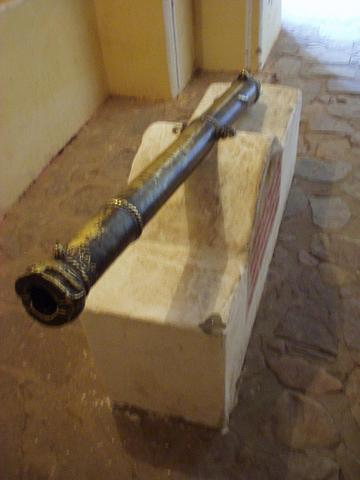 Jaigarh was famous for its canon foundry, and this is one of its progeny.
Jaigarh was famous for its canon foundry, and this is one of its progeny. |
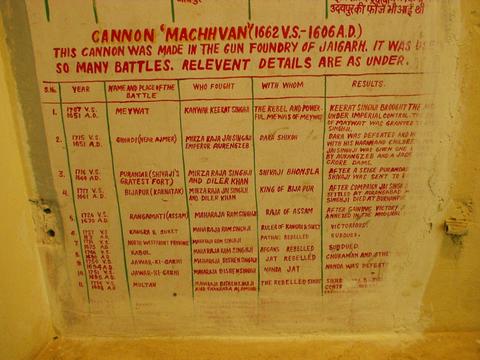 Machhvan the canon was in a museum of canons, each of which had its "résumé" posted next to it of all the battles it was in, and whether it won or lost. Usually military museums are boring, long racks of swords and armor, but this was interesting to think of all the places that each of these chunks of iron had been. I imagined the Rajas looking over these résumés, interviewing the canons: "Ah, yes, Mr. Machhvan. I see you did a good job blowing Shivanji's army to bits at Purandar, I'm sure I can find a place for you in my army."
Machhvan the canon was in a museum of canons, each of which had its "résumé" posted next to it of all the battles it was in, and whether it won or lost. Usually military museums are boring, long racks of swords and armor, but this was interesting to think of all the places that each of these chunks of iron had been. I imagined the Rajas looking over these résumés, interviewing the canons: "Ah, yes, Mr. Machhvan. I see you did a good job blowing Shivanji's army to bits at Purandar, I'm sure I can find a place for you in my army." |
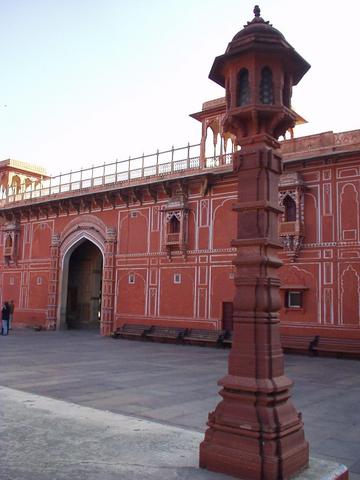 The red sandstone fort/palace within the city of Jaipur.
The red sandstone fort/palace within the city of Jaipur. |
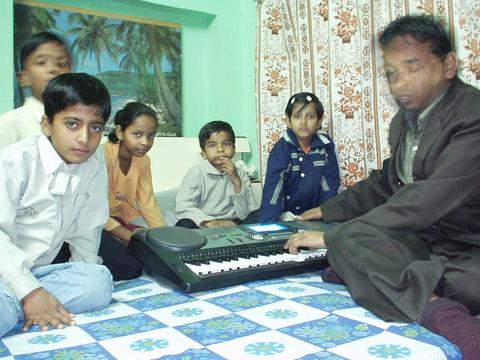 Usually when you meet people on the street, they want to sell you something; sometimes they just want to talk. Sometimes they're a professor of music with their wife and kids with them, and so I'd visit their home and have dinner and they'd sing for me -- okay, that's only happened once, with Mr. Bhagwan Das here.
Usually when you meet people on the street, they want to sell you something; sometimes they just want to talk. Sometimes they're a professor of music with their wife and kids with them, and so I'd visit their home and have dinner and they'd sing for me -- okay, that's only happened once, with Mr. Bhagwan Das here.
|
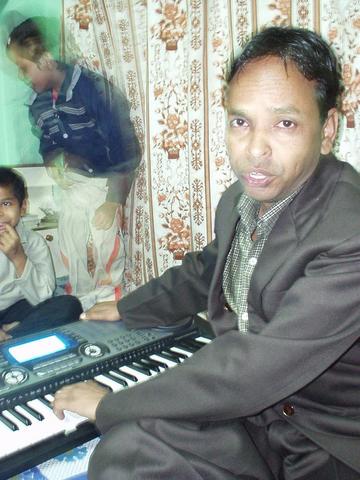 Bhagwan playing a ghazal. Bhagwan has a cozy job working as music professor, teaching students pursuing a masters degree at a state university. His dream, though, is a six to nine month sabbatical teaching Indian music (harmonium, tabla, sitar, voice) in the United States or the UK. If anybody knows how he could work that out, let me know.
Bhagwan playing a ghazal. Bhagwan has a cozy job working as music professor, teaching students pursuing a masters degree at a state university. His dream, though, is a six to nine month sabbatical teaching Indian music (harmonium, tabla, sitar, voice) in the United States or the UK. If anybody knows how he could work that out, let me know.
|
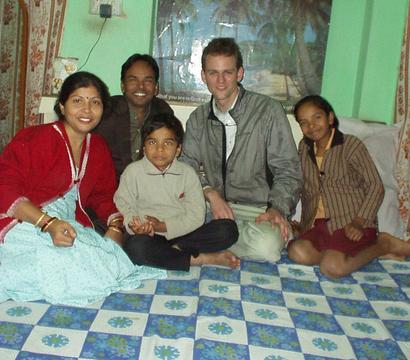 Bhagwan with his wife and two children. They had a "love marriage" -- that is, not an arranged marriage.
Bhagwan with his wife and two children. They had a "love marriage" -- that is, not an arranged marriage. |
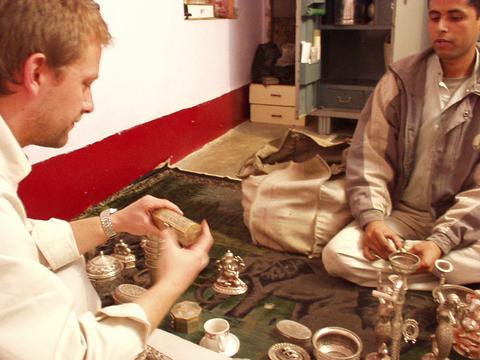 I travelled through Rajasthan by car, which I rented with Henrik Jorgensen, a Norwegian strategy and marketing consultant. Our driver took us to merchants selling whatever the going thing was in each town: wood-block prints in Jaipur, slver in Jaisalmer, hand stitched wall hangings in Jodhpur. I usually just bought a small token something, but Henrik was a shopper. It was fun to see everything that the merchants had for sale (without feeling guilty that I wasn't going to buy anything), and to see Henrik and the merchants haggle.
I travelled through Rajasthan by car, which I rented with Henrik Jorgensen, a Norwegian strategy and marketing consultant. Our driver took us to merchants selling whatever the going thing was in each town: wood-block prints in Jaipur, slver in Jaisalmer, hand stitched wall hangings in Jodhpur. I usually just bought a small token something, but Henrik was a shopper. It was fun to see everything that the merchants had for sale (without feeling guilty that I wasn't going to buy anything), and to see Henrik and the merchants haggle. |
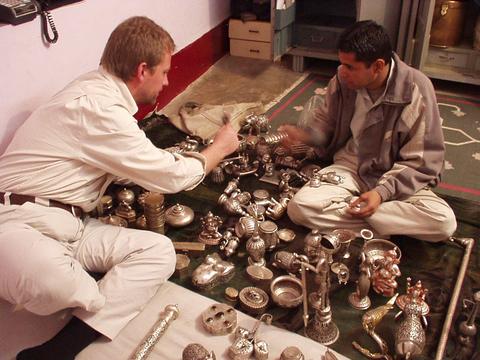 This silver merchant had an enormous collection of old (so he said) silver items: boxes, opium pipes, message tubes, a walking stick, a fish, et cetera. He dumped them out of a bag with a clattering, banging crash; it was like Ali Baba's horde.
This silver merchant had an enormous collection of old (so he said) silver items: boxes, opium pipes, message tubes, a walking stick, a fish, et cetera. He dumped them out of a bag with a clattering, banging crash; it was like Ali Baba's horde. |
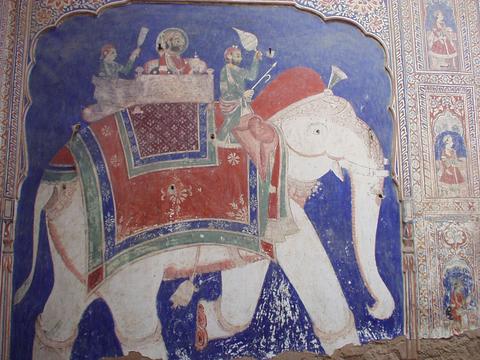 Wall painting from a haveli in Fatehpur, Rajasthan. The town of Fatehpur, like many in the Shekhawati region of Rajasthan, was formerly comprised mostly of these large mansions, called havelis, that were decorated throughout with colorful paintings. Now many of them are locked up, and/or occupied by poorer families that live in them and maintain them as well as they can.
Wall painting from a haveli in Fatehpur, Rajasthan. The town of Fatehpur, like many in the Shekhawati region of Rajasthan, was formerly comprised mostly of these large mansions, called havelis, that were decorated throughout with colorful paintings. Now many of them are locked up, and/or occupied by poorer families that live in them and maintain them as well as they can. |
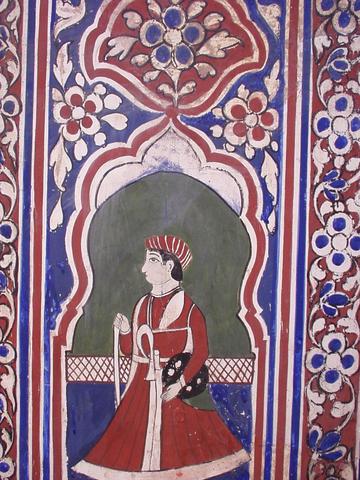 Detail of a painting from Nadine Le Prince's haveli. This one actually hadn't been restored; it was in a room where it had been protected by the elements and had therefore survived more or less intact.
Detail of a painting from Nadine Le Prince's haveli. This one actually hadn't been restored; it was in a room where it had been protected by the elements and had therefore survived more or less intact. |
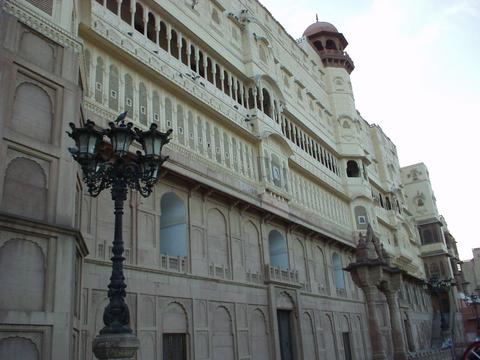 Exterior facade of Junagarh, Bikaner.
Exterior facade of Junagarh, Bikaner. |
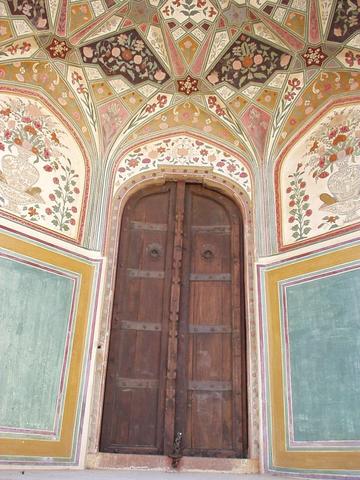 Doorway in the Amber Palace, near Jaipur.
Doorway in the Amber Palace, near Jaipur. |
 Family of musicians performing in Bikaner, Rajasthan.
Family of musicians performing in Bikaner, Rajasthan. It's really stunning how willing people are in India to have their picture taken - even to relish it, as this man did - if you just ask.
It's really stunning how willing people are in India to have their picture taken - even to relish it, as this man did - if you just ask. These women were in Chittaurgarh, an old military fort far away from cities, unlike many of the other Raj palaces.
These women were in Chittaurgarh, an old military fort far away from cities, unlike many of the other Raj palaces.  Camels loafing around the Sam Sand Dunes, Rajastan.
Camels loafing around the Sam Sand Dunes, Rajastan. A restored havleli in Fatehpur, Rajasthan.
A restored havleli in Fatehpur, Rajasthan. A jain holy man cleaning sculptures in the temple at Osiyan. He is wearing a mask to prevent him inhaling any insects, as part of a devout Jain practice of not harming any living thing.
A jain holy man cleaning sculptures in the temple at Osiyan. He is wearing a mask to prevent him inhaling any insects, as part of a devout Jain practice of not harming any living thing. Obligatory Taj Mahal picture. It was a foggy day, and the Taj blended into the fog. There was a mosque on the west side of it -- and, interestingly, on the east side there was a mirror image of that mosque, a building serving only to keep the symmetry: since it wasn't facing Mecca, it couldn't be used for worship.
Obligatory Taj Mahal picture. It was a foggy day, and the Taj blended into the fog. There was a mosque on the west side of it -- and, interestingly, on the east side there was a mirror image of that mosque, a building serving only to keep the symmetry: since it wasn't facing Mecca, it couldn't be used for worship.
 Close up of the Taj.
Close up of the Taj. Miniature painting, Udaipur. I spent most of the time in Udaipur being food-poisoned, so I only got out to take one digital picture; most of the miniature paintings in the city palace, like this one, seemed to depict noblemen fighting against either elephants or tigers, seemlingly for sport.
Miniature painting, Udaipur. I spent most of the time in Udaipur being food-poisoned, so I only got out to take one digital picture; most of the miniature paintings in the city palace, like this one, seemed to depict noblemen fighting against either elephants or tigers, seemlingly for sport. The fort at Kumbhalgarh; this is in a remote area and there were few tourists around. The black wall that you see receding into the distance is 23 miles long, enclosing a large area around the fort, with temples and a village that is still thriving (largely employed in restoring the fort, it seems).
The fort at Kumbhalgarh; this is in a remote area and there were few tourists around. The black wall that you see receding into the distance is 23 miles long, enclosing a large area around the fort, with temples and a village that is still thriving (largely employed in restoring the fort, it seems). The Jain Temple at Ranakpur, "one of the largest and most important Jain temples in India," according to Lonely Planet. It's large and seemed important; the amount of labor involved in the carving of the 1,444 pillars inside (no two are the same) is breathtaking.
The Jain Temple at Ranakpur, "one of the largest and most important Jain temples in India," according to Lonely Planet. It's large and seemed important; the amount of labor involved in the carving of the 1,444 pillars inside (no two are the same) is breathtaking. In Jodhpur we visited a merchant who sold these wall hanging/floor coverings that were made from the dresses that Rajasthani women would traditionally sew as dowry; he said that the art had been lost, so they are no longer made. Each one went for about two hundred and thirty dollars.
In Jodhpur we visited a merchant who sold these wall hanging/floor coverings that were made from the dresses that Rajasthani women would traditionally sew as dowry; he said that the art had been lost, so they are no longer made. Each one went for about two hundred and thirty dollars. Jodhpur fort and the Blue City.
Jodhpur fort and the Blue City. Room in the Meherangarh, the fort of Jodhpur; I didn't note which room it was, but the very colorful rooms like this, with glass or mirrors, were usually the residences of either the Maharaja or one of his ranis (wives).
Room in the Meherangarh, the fort of Jodhpur; I didn't note which room it was, but the very colorful rooms like this, with glass or mirrors, were usually the residences of either the Maharaja or one of his ranis (wives). Interior of the Jaswant Thada. There is a kind of altar in here where people tie a piece of string around their wrist and around a balustrade, and then break it, leaving half tied around their wrist, half around the balustrade; somebody (The Majaraja? A god? I forget.) then intervenes and helps them with some wish; when it is granted, they're supposed to come back and collect the string they left behind.
Interior of the Jaswant Thada. There is a kind of altar in here where people tie a piece of string around their wrist and around a balustrade, and then break it, leaving half tied around their wrist, half around the balustrade; somebody (The Majaraja? A god? I forget.) then intervenes and helps them with some wish; when it is granted, they're supposed to come back and collect the string they left behind. Every city seems to have a color in Rajasthan: Jaipur is the Pink City (it's walls were painted that color, associated with hospitality, to welcome the Prince of Wales who would become King Edward VII), Jaisalmer is the Golden City (named after the color of the rock from which the fort there was built), and Jodhpur is the Blue City, since many of the homes in the old city are painted that color, which is the traditional color of a Brahmin home (other castes now also paint their homes blue). Here, as seen from the battlements of Jodhpur's fort, a hawk soars above the Blue City.
Every city seems to have a color in Rajasthan: Jaipur is the Pink City (it's walls were painted that color, associated with hospitality, to welcome the Prince of Wales who would become King Edward VII), Jaisalmer is the Golden City (named after the color of the rock from which the fort there was built), and Jodhpur is the Blue City, since many of the homes in the old city are painted that color, which is the traditional color of a Brahmin home (other castes now also paint their homes blue). Here, as seen from the battlements of Jodhpur's fort, a hawk soars above the Blue City. This is a cenotaph of Maharaja Jaswant Singh II, called the Jaswant Thada. It was built in 1899 by his wife, sort of like a reverse Taj Mahal. All of the subsequent maharajas (or would-be maharajas) and other members of the royal family of Jodhpur are memorialized by cenotaphs around it; those of the kings are made of white marble, the others of red sandstone. As an interesting side note, the last maharaja died in the 1950s sometime, when his son, the current maharaja, was only four; the fort has many pictures of his coronation, looking very small and dignified. Oh yeah, and that's me, on the steps.
This is a cenotaph of Maharaja Jaswant Singh II, called the Jaswant Thada. It was built in 1899 by his wife, sort of like a reverse Taj Mahal. All of the subsequent maharajas (or would-be maharajas) and other members of the royal family of Jodhpur are memorialized by cenotaphs around it; those of the kings are made of white marble, the others of red sandstone. As an interesting side note, the last maharaja died in the 1950s sometime, when his son, the current maharaja, was only four; the fort has many pictures of his coronation, looking very small and dignified. Oh yeah, and that's me, on the steps. Man carving rock for an addition to a Jain temple, Osiyan, Rajasthan. The Jains are a wealthy community, and it showed from the amount of construction that was going on at their temples, particularly this one at Osiyan, a town between Jaisalmer and Jodhpur.
Man carving rock for an addition to a Jain temple, Osiyan, Rajasthan. The Jains are a wealthy community, and it showed from the amount of construction that was going on at their temples, particularly this one at Osiyan, a town between Jaisalmer and Jodhpur. Another man carving out the head of a figure for a pillar or tower of one of the Osiyan temples.
Another man carving out the head of a figure for a pillar or tower of one of the Osiyan temples. Tower of a Jain temple in Osiyan, Rajasthan.
Tower of a Jain temple in Osiyan, Rajasthan. Entrance to the same Jain temple in Osiyan, Rajasthan.
Entrance to the same Jain temple in Osiyan, Rajasthan. Turret in Junagarh fort, Bikaner. Bikaner is a town somewhat off the tourist track of Rajasthan, on the edge of the Thar desert about eighty miles from the Pakistani border. Turrets like these are a frequent distinguishing mark of Mughal architecture; Junagarh was built in the years 1588-1593 by a general of the great Mughal emperor Akbar.
Turret in Junagarh fort, Bikaner. Bikaner is a town somewhat off the tourist track of Rajasthan, on the edge of the Thar desert about eighty miles from the Pakistani border. Turrets like these are a frequent distinguishing mark of Mughal architecture; Junagarh was built in the years 1588-1593 by a general of the great Mughal emperor Akbar. Rajasthani man. They have turbans in orange, pink, yellow, patterened; many colors, but they are always very bright. Big mustaches are also the norm.
Rajasthani man. They have turbans in orange, pink, yellow, patterened; many colors, but they are always very bright. Big mustaches are also the norm. Almost all of the havelis are in a state of deterioration, but there was one that had been bought by a (wealthy) French artist named Nadine Le Prince and totally restored; she stops in once or twice a year with thirty of her closest friends and hangs out. Her caretakeer took me on a tour; it was an impressive sight, especially after seeing all of the other dilapidated havelis. This is one of the doorways in the complex.
Almost all of the havelis are in a state of deterioration, but there was one that had been bought by a (wealthy) French artist named Nadine Le Prince and totally restored; she stops in once or twice a year with thirty of her closest friends and hangs out. Her caretakeer took me on a tour; it was an impressive sight, especially after seeing all of the other dilapidated havelis. This is one of the doorways in the complex. Jaigarh was famous for its canon foundry, and this is one of its progeny.
Jaigarh was famous for its canon foundry, and this is one of its progeny. Machhvan the canon was in a museum of canons, each of which had its "résumé" posted next to it of all the battles it was in, and whether it won or lost. Usually military museums are boring, long racks of swords and armor, but this was interesting to think of all the places that each of these chunks of iron had been. I imagined the Rajas looking over these résumés, interviewing the canons: "Ah, yes, Mr. Machhvan. I see you did a good job blowing Shivanji's army to bits at Purandar, I'm sure I can find a place for you in my army."
Machhvan the canon was in a museum of canons, each of which had its "résumé" posted next to it of all the battles it was in, and whether it won or lost. Usually military museums are boring, long racks of swords and armor, but this was interesting to think of all the places that each of these chunks of iron had been. I imagined the Rajas looking over these résumés, interviewing the canons: "Ah, yes, Mr. Machhvan. I see you did a good job blowing Shivanji's army to bits at Purandar, I'm sure I can find a place for you in my army." The red sandstone fort/palace within the city of Jaipur.
The red sandstone fort/palace within the city of Jaipur. Usually when you meet people on the street, they want to sell you something; sometimes they just want to talk. Sometimes they're a professor of music with their wife and kids with them, and so I'd visit their home and have dinner and they'd sing for me -- okay, that's only happened once, with Mr. Bhagwan Das here.
Usually when you meet people on the street, they want to sell you something; sometimes they just want to talk. Sometimes they're a professor of music with their wife and kids with them, and so I'd visit their home and have dinner and they'd sing for me -- okay, that's only happened once, with Mr. Bhagwan Das here.
 Bhagwan playing a ghazal. Bhagwan has a cozy job working as music professor, teaching students pursuing a masters degree at a state university. His dream, though, is a six to nine month sabbatical teaching Indian music (harmonium, tabla, sitar, voice) in the United States or the UK. If anybody knows how he could work that out, let me know.
Bhagwan playing a ghazal. Bhagwan has a cozy job working as music professor, teaching students pursuing a masters degree at a state university. His dream, though, is a six to nine month sabbatical teaching Indian music (harmonium, tabla, sitar, voice) in the United States or the UK. If anybody knows how he could work that out, let me know.
 Bhagwan with his wife and two children. They had a "love marriage" -- that is, not an arranged marriage.
Bhagwan with his wife and two children. They had a "love marriage" -- that is, not an arranged marriage. I travelled through Rajasthan by car, which I rented with Henrik Jorgensen, a Norwegian strategy and marketing consultant. Our driver took us to merchants selling whatever the going thing was in each town: wood-block prints in Jaipur, slver in Jaisalmer, hand stitched wall hangings in Jodhpur. I usually just bought a small token something, but Henrik was a shopper. It was fun to see everything that the merchants had for sale (without feeling guilty that I wasn't going to buy anything), and to see Henrik and the merchants haggle.
I travelled through Rajasthan by car, which I rented with Henrik Jorgensen, a Norwegian strategy and marketing consultant. Our driver took us to merchants selling whatever the going thing was in each town: wood-block prints in Jaipur, slver in Jaisalmer, hand stitched wall hangings in Jodhpur. I usually just bought a small token something, but Henrik was a shopper. It was fun to see everything that the merchants had for sale (without feeling guilty that I wasn't going to buy anything), and to see Henrik and the merchants haggle. This silver merchant had an enormous collection of old (so he said) silver items: boxes, opium pipes, message tubes, a walking stick, a fish, et cetera. He dumped them out of a bag with a clattering, banging crash; it was like Ali Baba's horde.
This silver merchant had an enormous collection of old (so he said) silver items: boxes, opium pipes, message tubes, a walking stick, a fish, et cetera. He dumped them out of a bag with a clattering, banging crash; it was like Ali Baba's horde. Wall painting from a haveli in Fatehpur, Rajasthan. The town of Fatehpur, like many in the Shekhawati region of Rajasthan, was formerly comprised mostly of these large mansions, called havelis, that were decorated throughout with colorful paintings. Now many of them are locked up, and/or occupied by poorer families that live in them and maintain them as well as they can.
Wall painting from a haveli in Fatehpur, Rajasthan. The town of Fatehpur, like many in the Shekhawati region of Rajasthan, was formerly comprised mostly of these large mansions, called havelis, that were decorated throughout with colorful paintings. Now many of them are locked up, and/or occupied by poorer families that live in them and maintain them as well as they can. Detail of a painting from Nadine Le Prince's haveli. This one actually hadn't been restored; it was in a room where it had been protected by the elements and had therefore survived more or less intact.
Detail of a painting from Nadine Le Prince's haveli. This one actually hadn't been restored; it was in a room where it had been protected by the elements and had therefore survived more or less intact. Exterior facade of Junagarh, Bikaner.
Exterior facade of Junagarh, Bikaner.  Doorway in the Amber Palace, near Jaipur.
Doorway in the Amber Palace, near Jaipur.